Learning Outcomes
- Estimate the end behavior of a function as 𝑥 increases or decreases without bound
- Recognize an oblique asymptote on the graph of a function
The behavior of a function as [latex]x\to \pm \infty[/latex] is called the function’s end behavior. At each of the function’s ends, the function could exhibit one of the following types of behavior:
- The function [latex]f(x)[/latex] approaches a horizontal asymptote [latex]y=L[/latex].
- The function [latex]f(x)\to \infty[/latex] or [latex]f(x)\to −\infty[/latex].
- The function does not approach a finite limit, nor does it approach [latex]\infty[/latex] or [latex]−\infty[/latex]. In this case, the function may have some oscillatory behavior.
Let’s consider several classes of functions here and look at the different types of end behaviors for these functions.
End Behavior for Polynomial Functions
Consider the power function [latex]f(x)=x^n[/latex] where [latex]n[/latex] is a positive integer. From Figure 11 and Figure 12, we see that
and
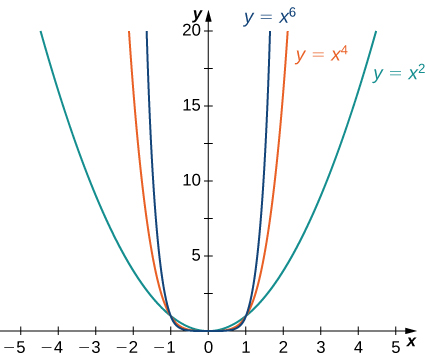
Figure 11. For power functions with an even power of [latex]n[/latex], [latex]\underset{x\to \infty }{\lim}x^n=\infty =\underset{x\to −\infty }{\lim}x^n[/latex].
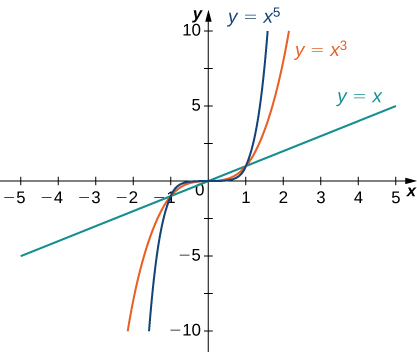
Figure 12. For power functions with an odd power of [latex]n[/latex], [latex]\underset{x\to \infty }{\lim}x^n=\infty [/latex] and [latex]\underset{x\to −\infty}{\lim}x^n=−\infty [/latex].
Using these facts, it is not difficult to evaluate [latex]\underset{x\to \infty }{\lim}cx^n[/latex] and [latex]\underset{x\to −\infty }{\lim}cx^n[/latex], where [latex]c[/latex] is any constant and [latex]n[/latex] is a positive integer. If [latex]c>0[/latex], the graph of [latex]y=cx^n[/latex] is a vertical stretch or compression of [latex]y=x^n[/latex], and therefore
If [latex]c<0[/latex], the graph of [latex]y=cx^n[/latex] is a vertical stretch or compression combined with a reflection about the [latex]x[/latex]-axis, and therefore
If [latex]c=0, \, y=cx^n=0[/latex], in which case [latex]\underset{x\to \infty }{\lim}cx^n=0=\underset{x\to −\infty }{\lim}cx^n[/latex].
Example: Limits at Infinity for Power Functions
For each function [latex]f[/latex], evaluate [latex]\underset{x\to \infty }{\lim}f(x)[/latex] and [latex]\underset{x\to −\infty }{\lim}f(x)[/latex].
- [latex]f(x)=-5x^3[/latex]
- [latex]f(x)=2x^4[/latex]
Watch the following video to see the worked solution to Example: Limits at Infinity for Power Functions.
Try It
Let [latex]f(x)=-3x^4[/latex]. Find [latex]\underset{x\to \infty }{\lim}f(x)[/latex].
We now look at how the limits at infinity for power functions can be used to determine [latex]\underset{x\to \pm \infty }{\lim}f(x)[/latex] for any polynomial function [latex]f[/latex]. Consider a polynomial function
of degree [latex]n \ge 1[/latex] so that [latex]a_n \ne 0[/latex]. Factoring, we see that
As [latex]x\to \pm \infty[/latex], all the terms inside the parentheses approach zero except the first term. We conclude that
For example, the function [latex]f(x)=5x^3-3x^2+4[/latex] behaves like [latex]g(x)=5x^3[/latex] as [latex]x\to \pm \infty[/latex] as shown in Figure 13 and Table 1.

Figure 13. The end behavior of a polynomial is determined by the behavior of the term with the largest exponent.
| [latex]x[/latex] | 10 | 100 | 1000 |
| [latex]f(x)=5x^3-3x^2+4[/latex] | 4704 | 4,970,004 | 4,997,000,004 |
| [latex]g(x)=5x^3[/latex] | 5000 | 5,000,000 | 5,000,000,000 |
| [latex]x[/latex] | -10 | -100 | -1000 |
| [latex]f(x)=5x^3-3x^2+4[/latex] | -5296 | -5,029,996 | -5,002,999,996 |
| [latex]g(x)=5x^3[/latex] | -5000 | -5,000,000 | -5,000,000,000 |
End Behavior for Algebraic Functions
The end behavior for rational functions and functions involving radicals is a little more complicated than for polynomials. In the example below, we show that the limits at infinity of a rational function [latex]f(x)=\frac{p(x)}{q(x)}[/latex] depend on the relationship between the degree of the numerator and the degree of the denominator. To evaluate the limits at infinity for a rational function, we divide the numerator and denominator by the highest power of [latex]x[/latex] appearing in the denominator. This determines which term in the overall expression dominates the behavior of the function at large values of [latex]x[/latex].
Note that this is not your first encounter with horizontal asymptotes. It may be helpful to recall what you already know about them.
Recall: Horizontal Asymptotes of Rational Functions
The horizontal asymptote of a rational function can be determined by looking at the degrees of the numerator and denominator.
- Case 1: Degree of numerator is less than degree of denominator: horizontal asymptote at [latex]y=0[/latex]
- Case 2: Degree of numerator is greater than degree of denominator by one: no horizontal asymptote; slant asymptote.
- If the degree of the numerator is greater than the degree of the denominator by more than one, the end behavior of the function’s graph will mimic that of the graph of the reduced ratio of leading terms.
- Case 3: Degree of numerator is equal to degree of denominator: horizontal asymptote at ratio of leading coefficients.
Example: Determining End Behavior for Rational Functions
For each of the following functions, determine the limits as [latex]x\to \infty[/latex] and [latex]x\to −\infty[/latex]. Then, use this information to describe the end behavior of the function.
- [latex]f(x)=\frac{3x-1}{2x+5}[/latex] (Note: The degree of the numerator and the denominator are the same.)
- [latex]f(x)=\frac{3x^2+2x}{4x^3-5x+7}[/latex] (Note: The degree of numerator is less than the degree of the denominator.)
- [latex]f(x)=\frac{3x^2+4x}{x+2}[/latex] (Note: The degree of numerator is greater than the degree of the denominator.)
Watch the following video to see the worked solution to Example: Determining End Behavior for Rational Functions.
Try It
Evaluate [latex]\underset{x\to \pm \infty }{\lim}\dfrac{3x^2+2x-1}{5x^2-4x+7}[/latex] and use these limits to determine the end behavior of [latex]f(x)=\dfrac{3x^2+2x-1}{5x^2-4x+7}[/latex].
Before proceeding, consider the graph of [latex]f(x)=\frac{(3x^2+4x)}{(x+2)}[/latex] shown in Figure 17. As [latex]x\to \infty[/latex] and [latex]x\to −\infty[/latex], the graph of [latex]f[/latex] appears almost linear. Although [latex]f[/latex] is certainly not a linear function, we now investigate why the graph of [latex]f[/latex] seems to be approaching a linear function. First, using long division of polynomials, we can write
Since [latex]\frac{4}{(x+2)}\to 0[/latex] as [latex]x\to \pm \infty[/latex], we conclude that
Therefore, the graph of [latex]f[/latex] approaches the line [latex]y=3x-2[/latex] as [latex]x\to \pm \infty[/latex]. This line is known as an oblique asymptote for [latex]f[/latex] (Figure 17).
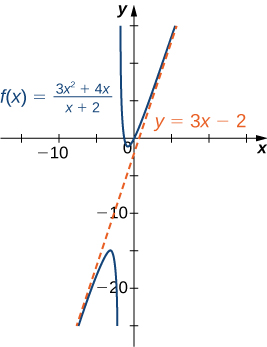
Figure 17. The graph of the rational function [latex]f(x)=(3x^2+4x)/(x+2)[/latex] approaches the oblique asymptote [latex]y=3x-2[/latex] as [latex]x\to \pm \infty[/latex].
We can summarize the results of the example above to make the following conclusion regarding end behavior for rational functions. Consider a rational function
where [latex]a_n\ne 0[/latex] and [latex]b_m \ne 0[/latex].
- If the degree of the numerator is the same as the degree of the denominator [latex](n=m)[/latex], then [latex]f[/latex] has a horizontal asymptote of [latex]y=a_n/b_m[/latex] as [latex]x\to \pm \infty[/latex].
- If the degree of the numerator is less than the degree of the denominator [latex](n
- If the degree of the numerator is greater than the degree of the denominator [latex](n>m)[/latex], then [latex]f[/latex] does not have a horizontal asymptote. The limits at infinity are either positive or negative infinity, depending on the signs of the leading terms. In addition, using long division, the function can be rewritten as
[latex]f(x)=\frac{p(x)}{q(x)}=g(x)+\frac{r(x)}{q(x)}[/latex],where the degree of [latex]r(x)[/latex] is less than the degree of [latex]q(x)[/latex]. As a result, [latex]\underset{x\to \pm \infty }{\lim}r(x)/q(x)=0[/latex]. Therefore, the values of [latex][f(x)-g(x)][/latex] approach zero as [latex]x\to \pm \infty[/latex]. If the degree of [latex]p(x)[/latex] is exactly one more than the degree of [latex]q(x)[/latex] [latex](n=m+1)[/latex], the function [latex]g(x)[/latex] is a linear function. In this case, we call [latex]g(x)[/latex] an oblique asymptote.
Now let’s consider the end behavior for functions involving a radical. - If the degree of the numerator is greater than the degree of the denominator [latex](n>m)[/latex], then [latex]f[/latex] does not have a horizontal asymptote. The limits at infinity are either positive or negative infinity, depending on the signs of the leading terms. In addition, using long division, the function can be rewritten as
Example: Determining End Behavior for a Function Involving a Radical
Find the limits as [latex]x\to \infty[/latex] and [latex]x\to −\infty[/latex] for [latex]f(x)=\frac{3x-2}{\sqrt{4x^2+5}}[/latex] and describe the end behavior of [latex]f[/latex].
Try It
Evaluate [latex]\underset{x\to \infty }{\lim}\frac{\sqrt{3x^2+4}}{x+6}[/latex].
Try It
Determining End Behavior for Transcendental Functions
The six basic trigonometric functions are periodic and do not approach a finite limit as [latex]x\to \pm \infty[/latex]. For example, [latex]\sin x[/latex] oscillates between 1 and -1 (Figure 19). The tangent function [latex]x[/latex] has an infinite number of vertical asymptotes as [latex]x\to \pm \infty[/latex]; therefore, it does not approach a finite limit nor does it approach [latex]\pm \infty[/latex] as [latex]x\to \pm \infty[/latex] as shown in (Figure 20).
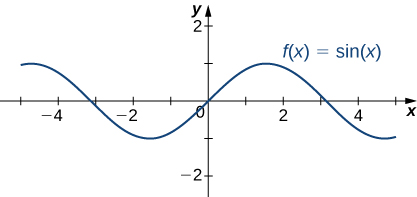
Figure 19. The function [latex]f(x)= \sin x[/latex] oscillates between 1 and -1 as [latex]x\to \pm \infty [/latex]
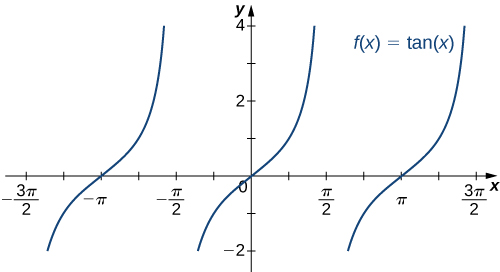
Figure 20. The function [latex]f(x)= \tan x[/latex] does not approach a limit and does not approach [latex]\pm \infty [/latex] as [latex]x\to \pm \infty [/latex]
Recall that for any base [latex]b>0, \, b\ne 1[/latex], the function [latex]y=b^x[/latex] is an exponential function with domain [latex](−\infty ,\infty )[/latex] and range [latex](0,\infty )[/latex]. If [latex]b>1, \, y=b^x[/latex] is increasing over [latex](−\infty ,\infty )[/latex]. If [latex]0
| [latex]x[/latex] | -5 | -2 | 0 | 2 | 5 |
| [latex]e^x[/latex] | 0.00674 | 0.135 | 1 | 7.389 | 148.413 |
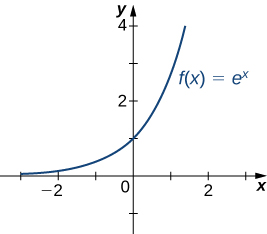
Figure 21. The exponential function approaches zero as [latex]x\to −\infty [/latex] and approaches [latex]\infty [/latex] as [latex]x\to \infty[/latex].
Recall that the natural logarithm function [latex]f(x)=\ln (x)[/latex] is the inverse of the natural exponential function [latex]y=e^x[/latex]. Therefore, the domain of [latex]f(x)=\ln (x)[/latex] is [latex](0,\infty )[/latex] and the range is [latex](−\infty ,\infty )[/latex]. The graph of [latex]f(x)=\ln (x)[/latex] is the reflection of the graph of [latex]y=e^x[/latex] about the line [latex]y=x[/latex]. Therefore, [latex]\ln (x)\to −\infty[/latex] as [latex]x\to 0^+[/latex] and [latex]\ln (x)\to \infty[/latex] as [latex]x\to \infty[/latex] as shown in (Figure) and (Figure).
| [latex]x[/latex] | 0.01 | 0.1 | 1 | 10 | 100 |
| [latex]\ln (x)[/latex] | -4.605 | -2.303 | 0 | 2.303 | 4.605 |
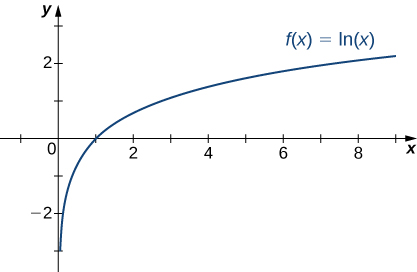
Figure 22. The natural logarithm function approaches [latex]\infty [/latex] as [latex]x\to \infty[/latex].
example: Determining End Behavior for a Transcendental Function
Find the limits as [latex]x\to \infty[/latex] and [latex]x\to −\infty[/latex] for [latex]f(x)=\frac{(2+3e^x)}{(7-5e^x)}[/latex] and describe the end behavior of [latex]f[/latex].
Watch the following video to see the worked solution to Example: Determining End Behavior for a Transcendental Function.
Try It
Find the limits as [latex]x\to \infty[/latex] and [latex]x\to −\infty[/latex] for [latex]f(x)=\dfrac{(3e^x-4)}{(5e^x+2)}[/latex].
Candela Citations
- 4.6 Limits at Infinity and Asymptotes. Authored by: Ryan Melton. License: CC BY: Attribution
- Calculus Volume 1. Authored by: Gilbert Strang, Edwin (Jed) Herman. Provided by: OpenStax. Located at: https://openstax.org/details/books/calculus-volume-1. License: CC BY-NC-SA: Attribution-NonCommercial-ShareAlike. License Terms: Access for free at https://openstax.org/books/calculus-volume-1/pages/1-introduction




